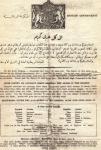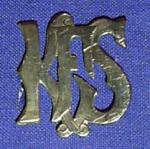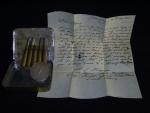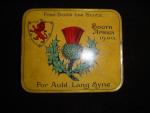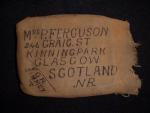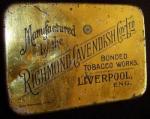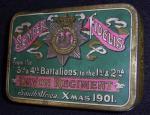-
Posts
2,111 -
Joined
-
Last visited
-
Days Won
11
Content Type
Profiles
Forums
Blogs
Gallery
Events
Store
Everything posted by QSAMIKE
-
Hello Paddy..... They would be 3 different regimental numbers...... Each regiment would assign him a new number, I have one group of 7 in my collection and there are 5 different numbers from the different units he served in from the Boer War through WW1...... I also have a QSA/KSA pair with 2 different numbers and 2 different units..... When the original unit went home there were 50 volunteers who stayed behind and went into a second unit with a new number..... Mike
-

Field writing case
QSAMIKE replied to Setpoint's topic in Great Britain: Militaria: Badges, Uniforms & Equipment
I thought he was buried in St. Pauls or is that just a memorial????? Mike -

Abbreviation help
QSAMIKE replied to Tony's topic in Great Britain: Militaria: Badges, Uniforms & Equipment
Good Morning Tony....... That is the name of a town in that section of the form, the title area is missing...... Olrig is a parish in Caithness, Scotland and the main settlement in the parish is Castletown..... Mike -
Yes it is quite normal...... Mike
-

BLOOD CHIT - BRITISH / ARABIC
QSAMIKE replied to QSAMIKE's topic in Great Britain: Militaria: Badges, Uniforms & Equipment
Gentlemen: Been doing some more digging and I understand that most of not all WW2 chits were made from silk just like the escape maps...... Mike -
Good Afternoon Gentlemen...... Not my field of collecting..... Can you please have a look at this Blood Chit / Good Conduct Pass that would have been used in the Middle East....... There is no date on the document and it is made of threat reinforced cloth paper..... My question is: World War One or World War Two?????????? Hope the picture is OK as to be able to post I had to reduce it twice..... Actual size is 8 x 10 Inches..... Mike
-

SCOTTISH REGIMENTS TOBACCO TIN
QSAMIKE replied to QSAMIKE's topic in Great Britain: Militaria: Badges, Uniforms & Equipment
More Pictures...... To bad you cannot input more than one at a time....... One site has no limit....... Mike Coming attractions...... Royal Scots Grey's Tin, Keen's Mustard Tin, Tea Tin shaped as Shell........ -

SCOTTISH REGIMENTS TOBACCO TIN
QSAMIKE replied to QSAMIKE's topic in Great Britain: Militaria: Badges, Uniforms & Equipment
-

SCOTTISH REGIMENTS TOBACCO TIN
QSAMIKE replied to QSAMIKE's topic in Great Britain: Militaria: Badges, Uniforms & Equipment
-
Good Morning Ladies and Gentlemen.... Please find attached some photos of the Scottish Tobacco Tin complete with mailing packaging which looks like it was a piece of uniform.... I am afraid that this tin is empty as I have never seen a full one.... I guess the troops liked to smoke better than they liked to eat chocolate..... When purchased there was a letter in the tin, transcribed below along with a clip of 4 mauser cartridges live, one casing and one silver Peace/Memorial medal. SIZE: 82 mm X 100 mm X 16 mm Inscription on top of tin "Frae Scots Tae Scots, South Africa 1900, For Auld Lang Syne"..... Yellow in colour with Green and Red Thistle and Red Shiled, Black printing..... This tin is quite rare as I have only ever seen 5 of them for sale in the many years that I have been collecting Boer War items..... Mike ########################################################### Johannesburg, 13th Dec, 1900 Transvaal Dear Friend: Just a few lines to let you know I got your present and I thank you very much for it this Box I am sending you is the one sent out by the people of Scotland to Scottish Regiments serving in South Africa I would have sent you the tobacco also only it was mildewed there is a Kruger Shilling and 6 cartridge cases 4 are still loaded and 2 are pencil cases these were taken from a dead Boer at the battle of Fredrikstad they are loaded in 5s at a time into the Mauser that is the reason of the clip to hold them I conclude wishing you a Merry Xmas & a Happy New Year Pte. S Ferguson 2nd Royal Scots Fusiliers E Coy South African Field Force South Africa
-
Hello Graeme..... Sorry your man did not serve in Mafeking unless he was a Train Driver, there were no Gordon Highlanders at Mafeking...... He is not listed as a casualty of any type during Boer War..... Lack of star means he did not get to France till after 1915..... The Gordon Highlanders in the Boer War: 1st Battalion The 1st Battalion sailed on the Cheshire on 9th November 1899, and arrived at the Cape on 28th November. When the war broke out the old 75th, or Dargai battalion, were the garrison at Edinburgh. On the day after Nicholson's Nek, when it was seen more troops were needed, the battalion was ordered to sail nine days later, and on their arrival in South Africa it was not to be expected that so efficient a battalion would be long at the base. Within ten days of their arrival they were thrown into the bloody field of Magersfontein to help their hardly-pressed brothers in the Highland Brigade. The story of the fatal day has been briefly told under the Black Watch, but as the Gordons were not in the brigade a sketch of their doings may be given. In his despatch of 15th February 1900 Lord Methuen says: "At 12 noon I ordered the battalion of the Gordons, which was with the supply column, to support the Highland Brigade. The trenches, even after the bombardment by lyddite and shrapnel since daybreak, were too strongly held to be cleared. The Gordons advanced in separate half-battalions, and though the attack could not be carried home the battalion did splendid work throughout the day". Lord Methuen afterwards says that Colonel Downman of the Gordons gave the order to "retire" after the right flank of the Gordons had become exposed to an enfilade fire. This retirement by Colonel Downman's order Lord Methuen seems to describe as unfortunate. The despatch is printed under the 2nd Black Watch; it is not quite clear on this and some other points. It is only fair to the memory of Colonel Downman and to his battalion to state that there are the best possible grounds for believing that Lord Methuen was not accurately informed of what did take place. Two officers, a doctor, the late Colonel Downman's signalling sergeant, and a private, who were all close to him when he fell, concur in stating that when the enfilade fire on the right of the Gordons commenced Colonel Downman rose up and ran towards the right, he shouted and signalled to throw back the right and bring up the left, this being the only effectual method of meeting the flanking fire. While giving these orders the colonel was mortally wounded. The Gordons' losses at Magersfontein were Colonel Downman and 2 other officers and 4 men killed, and 2 officers and 35 men wounded. Captain Towse, who afterwards got the VC, and 2 non-commissioned officers were mentioned in Lord Methuen's despatch for great gallantry. When Lord Roberts arrived at Modder River early in February, the Gordons, along with the 2nd Duke of Cornwall's Light Infantry, the 2nd Shropshire Light Infantry, and the Canadian Regiment, were placed in the 19th Brigade under Smith-Dorrien, and the IXth Division under General Colvile. Some account of the very fine work of the brigade, from its formation to the taking of Pretoria, is given under the Cornwalls; but in some actions the 1st Gordons had bits of the play all to themselves, and these it is not out of place to refer to here. At Paardeberg the Gordons were not so heavily engaged on the 18th as the other battalions of the division, but, like the others, they did very fine work on that and during the next nine days. On the night of the 22nd the Gordons relieved the Shropshires in the advanced trenches up the river bed, the men having to crawl on their stomachs in carrying out the relief. In the final move forward on the night of the 27th they supported the Canadians in their splendid advance, by which our troops got established within 80 yards of Cronje's trenches, which, as Lord Roberts said in his telegram of 27th February 1900 and despatch of 28th February, "apparently clinched matters". At Paardeberg the Gordons had 4 officers wounded and about 25 other casualties. Three officers, 5 non-commissioned officers, and 1 private were mentioned by Lord Roberts in his despatch of 31st March for their good work up to the taking of Bloemfontein. At Hout Nek on 30th April, after the 19th Brigade had become part of Ian Hamilton's division, the Boer position was found to be very strong and held with great determination. Mr Churchill, in describing a critical part of the action, when the enemy were receiving continual reinforcements, says: "At last about two o'clock some one hundred and fifty of the German Corps of the Boer force advanced from the northern point of Thoba in four lines across the table-top to drive the British off the hill. So regular was their order that it was not until their levelled rifles were seen pointing south that they were recognised as foes, and artillery opened on them. In spite of an accurate shell-fire they continued to advance boldly against the highest part of the hill, and meanwhile, cloaked by a swell of the ground, Captain Towse of the Gordon Highlanders, with twelve men of his own regiment and ten of Kitchener's Horse, was steadily moving towards them. The scene on the broad stage of the Thoba plateau was intensely dramatic. The whole army were the witnesses. The two forces, strangely disproportioned, drew near to each other. Neither was visible to the other. The unexpected collision impended. From every point field glasses were turned on the spectacle, and even hardened soldiers held their breath. At last, with suddenness, both parties came face to face at fifty yards' distance. The Germans, who had already made six prisoners, called loudly on Captain Towse and his little band to surrender. What verbal answer was returned is not recorded; but a furious splutter of musketry broke out at once, and in less than a minute the long lines of the enemy recoiled in confusion, and the top of the hill was secured to the British". It was on this occasion that Captain Towse was blinded by a bullet. Thus, as Mr Churchill says, "do Misery and Joy walk hand in hand on the field of war". An officer who was present thinks the enemy took no prisoners, certainly he took no Gordons. One month later at Doornkop or Florida, south-west of Johannesburg, the whole battalion got its chance, and as usual took it. As has been explained elsewhere, Ian Hamilton's force had been thrown across the front of the main army and had become the army of the left flank. On 29th May it was seen the enemy were strongly posted and clearly meant to make a stand on the ridges south of the main Rand and south-west of Florida. French with the cavalry tried a wide turning movement from the British left, but the ground was very difficult and progress slow. Late in the afternoon it was apparent the infantry must do it, and by the now dreaded frontal attack. It is very wrong to quote again a long passage from Mr Churchill, but if the objection were made by any one jealous of the Gordons, it might be replied that another eyewitness, Mr March Phillipps, of the Imperial Yeomanry, the clever author of 'With Rimington', describes the scene in terms almost identical with the following, and he too characterises the advance as, "I think, the finest performance I have seen in the whole campaign ": "The leading battalion of the 19th Brigade chanced, for there was no selection, to be the Gordon Highlanders, nor was it without a thrill that I watched this famous regiment move against the enemy. Their extension and advance were conducted with machine-like regularity. The officers explained what was required to the men. They were to advance rapidly until under rifle-fire, and then to push on or not as they might be instructed. With impassive unconcern the veterans of Chitral, Dargai, the Bara Valley, Magersfontein, Paardeberg, and Hout Nek walked leisurely forward, and the only comment recorded was the observation of a private, 'Bill, this looks like being a kopje day'. Gradually the whole battalion drew out clear of the covering ridge, and long dotted lines of brown figures filled the plain". After speaking of the artillery-fire, Mr Churchill says: "Yet when every allowance has been made for skilful direction and bold leading, the honours, equally with the cost of the victory, belong more to the Gordon Highlanders than to all the other troops put together. The rocks against which they advanced proved in the event to be the very heart of the enemy's position. The grass in front of them was burnt and burning, and against this dark background the khaki figures showed distinctly. The Dutch held their fire until the attack was within 800 yards, and then, louder than the cannonade, the ominous rattle of concentrated rifle-fire burst forth. The black slope was spotted as thickly with grey puffs of dust where the bullets struck as with advancing soldiers, and tiny figures falling by the way told of heavy loss. But the advance neither checked nor quickened. With remorseless stride, undisturbed by peril or enthusiasm, the Gordons swept steadily onward, changed direction half left to avoid, as far as possible, an enfilade fire, changed again to the right to effect a lodgment on the end of the ridge most suitable to attack, and at last rose up together to charge. The black slope twinkled like jet with the unexpected glitter of bayonets. The rugged sky line bristled with kilted figures, as, in perfect discipline and disdainful silence, those splendid soldiers closed on their foe. The Boers shrank from the contact. Discharging their magazines furiously, and firing their guns twice at point-blank range, they fled in confusion to the main ridge, and the issue of the action was no longer undecided". The Gordons were led by Lieutenant Colonel Burney and by Colonel Forbes Macbean, who has perhaps seen more hard fighting than any officer now alive and with his regiment. In closing his description of this action Mr March Phillipps says: "To walk steadily on through a fire of this sort, which gets momentarily hotter and better aimed as he diminishes the distance between himself and the enemy, in expectation every instant of knowing 'what it feels like', is the highest test of courage that a soldier in these days can give ... Knowing exactly from experience what lay in front of them, these Gordons were as cool as cucumbers. As they lay among the stones with us before beginning the advance, I spoke to several, answering their questions and pointing them out the lie of the ground and the Boer position. You could not have detected the least trace of anxiety or concern in any of them. The front rank, when the order to advance was given, stepped down with a swing of the kilt and a swagger that only a Highland regiment has. 'Steady on the left', they took their dressing as they reached the flat. Some one sang out, 'When under fire wear a cheerful face'; and the men laughingly passed the word along, 'When under fire wear a cheerful face'". In a telegram to 'The Morning Post' their brilliant correspondent remarked, "There is no doubt they are the finest regiment in the world". Such a sentence might cause heart-burnings, but at least there is some ground for it. The reference in Lord Roberts' telegram, "whose advance excited the admiration of all", is alone sufficient to make the men of the north-east of Scotland very proud. The losses of the Gordons were severe. Real glory is never to be bought by a regiment at a low price. Captain St John Meyrick and 19 men were killed, Lieutenant Colonel Burney and other 8 officers and about 70 men were wounded. The three officers of the Volunteer company were among the wounded. Corporal J.F. Mackay was awarded the VC for conspicuous bravery in dressing the wounds of comrades and carrying one man some distance under very heavy fire. On 10th July Smith-Dorrien was directed to take the Gordons and Shropshires to Krugersdorp to collect supplies north-west of that town. On the 11th the enemy were found very strongly posted. Two guns were pushed too far forward and could not be taken back by horses. Fifteen out of 17 gunners were shot down, but this did not deter the Gordons from making a desperate effort, and ultimately the guns were recovered. Captain and Adjutant W E Gordon rushed out and tied a rope to a gun, and then got his men to haul it back. Captain Gordon got the VC, and Captain Younger would also have got the coveted honour had he not died of wounds he received. Captain Gordon had been dangerously wounded at Magersfontein. When Lord Roberts had advanced eastwards to about Belfast, it was seen that the country north of that and on the way to Lydenburg was so difficult that General Buller with two brigades would not be able to attain his objective. Accordingly a column consisting of the 1st Royal Scots, 1st Royal Irish Regiment, and 1st Gordons, with ten guns, was placed under General Ian Hamilton to penetrate northwards and on the left flank of Buller. When Buller and Ian Hamilton had occupied Lydenburg, where, by the way, the 1st and 2nd Battalions had a memorable meeting, Hamilton turned south again to the main line and then marched to Koomati Poort. Here again, on 30th September, the Gordons had a misfortune through an explosion among some ammunition which had been left by the Boers. One man was killed and 1 officer and 19 men were injured. In November the battalion was operating near Belfast under Smith-Dorrien, and on the 2nd had some stiff rear-guard fighting, in which they lost 1 man killed and 1 officer and 7 men wounded. Twenty-seven officers and 39 non-commissioned officers and men were mentioned in Lord Roberts' final despatch, but these commendations embraced both 1st and 2nd Battalions. The 1st Battalion formed part of the garrison of Belfast when it was attacked on 7th to 8th January 1901. The attack was repulsed, the Gordons' losses being 3 killed and 14 wounded. General Ben Viljoen in his book on the war deals with the attack on Belfast, and lavishes great praise on the defenders, the Royal Irish Regiment and Gordon Highlanders. The battalion was to have no more heavy fighting. Their history after this date is like that of most of the infantry, garrison and blockhouse work, varied by a trek as occasion arose. Always doing well,, mixed up in no regrettable incidents, the Dargai battalion all through the two and a half years' fighting which they saw maintained their splendid reputation absolutely unsullied, and confirmed the opinion long formed by competent judges that as a fighting unit they could not be excelled. Towards the close of the war the battalion was brought to the Pretoria district. The Mounted Infantry company of the battalion was with Colonel De Lisle when that officer was assisting to drive the enemy out of Cape Colony in January and February 1901, and they were also with him when acting under General Elliot in the north-east of the Orange River Colony, May to July 1901. On 5th June Major Sladen (East Yorkshire Regiment) marched to Graspan, near Reitz, to intercept a convoy. The laager was found in the early morning of the 6th and captured, 45 prisoners being taken. Major Sladen sent back 40 men to inform Colonel De Lisle. About noon 500 Boers under Fourie, Delarey, and De Wet made a determined attempt to recapture the convoy. "During the close fighting which ensued the Boers succeeded in removing some of the captured waggons, which were parked outside the position, but failed to make any impression on the defence". In his telegram of 15th June Lord Kitchener said the Mounted Infantry "behaved with great gallantry". Reinforcements arrived at three, and the enemy retired in haste, and were pursued, the waggons being taken again. The Gordons lost Lieutenant Cameron and 10 men killed and 10 wounded. Lieutenant Cameron was mentioned in despatches. Lieutenant White got the DSO for "having been taken prisoner, and stripped, escaped, ran six miles, and brought up reinforcements". Sergeant Sutherland got the distinguished conduct medal for preventing the escape of 40 prisoners, although the enemy was within ten yards and he severely wounded in bringing in a comrade. Four others of the little band were mentioned for great courage and example. The sorrows of horsemanship had not affected the Highlanders' pluck. A few other mentions were picked up in the latter phases of the war. In the supplementary or final despatch 7 officers and 6 non-commissioned officers of the Gordons were mentioned, but these embraced both battalions. 2nd Battalion The 2nd Battalion was one of the four infantry battalions which, along with three cavalry regiments and three batteries of artillery, were despatched from India to Natal in September 1899, when war was a foregone conclusion. The 2nd Gordons were part of the force in Ladysmith when General Penn-Symons and his force were at Dundee, and they were not at Talana Hill, but, along with the 1st Devon and 1st Manchester, were brigaded under Colonel Ian Hamilton, and with him fought at Elandslaagte, 21st October 1899. The 2nd Gordons took a very prominent part in that battle, and out of the five companies present—about 425 officers and men—they had 123 casualties. Major Denne and 4 lieutenants were killed. Colonel W H Dick-Cunyngham and 7 other officers were wounded; 27 men were killed and 83 wounded. Only 3 officers present were untouched. The action brought two VC's to the battalion, those of Lieutenant Meiklejohn and Sergeant Major Robertson. Three officers and 1 non-commissioned officer were mentioned in Sir G White's despatch of 2nd December 1899. On 24th October General White fought the battle of Rietfontein in order to engage the attention of the Boers and prevent them attacking General Yule's column, then retreating from Dundee. The Gordons did not take part in that action. On mournful Monday, 30th October, the battle known as Lombard's Kop, Farquhar's Farm, and Nicholson's Nek—really the battle of Ladysmith—was fought. The 2nd Gordons, along with the 1st Devon, 1st Manchester, and 2nd Rifle Brigade, still under Colonel Ian Hamilton, were in the centre; but the real fighting took place entirely on the flanks, the left, which was in the air, being captured bodily and the right being forced to retire. That retirement Hamilton's men covered, and but for them and the artillery it might have become a rout. On 6th January the great attack on Ladysmith took place. It had been said that the Boers would not act on the offensive; that day disproved the assertion. The brunt of the attack fell on Caesar's Camp and Waggon Hill, neither of which had been intrenched quite as they should have been (see 2nd Rifle Brigade). The defenders at first were—on Caesar's Camp the 1st Man-chesters, the 42nd RFA, some sailors with a 12-pounder gun, and some Natal Volunteers; on Waggon Hill three companies King's Royal Rifles and a squadron Imperial Light Horse, besides some Royal Engineers and a working party of Gordons who were preparing a gun-emplacement. Waggon Hill was attacked at 2.30 am and Caesar's Camp at 3 am. At daylight the Imperial Light Horse reached Waggon Hill and the Gordons Caesar's Camp, followed by four companies 1st King's Royal Rifles and four companies 2nd King's Royal Rifles to Waggon Hill and the 2nd Rifle Brigade to Caesar's Camp. Early in the forenoon the 5th Lancers arrived at Caesar's Camp and the 18th Hussars at Waggon Hill. The 5th Dragoon Guards and one and a half squadrons of the 19th Hussars further reinforced Waggon Hill about four o'clock. Fiercer fighting was not seen in the whole campaign, and it raged on both hills from daybreak till 5 pm, when a final charge by three companies of the 1st Devons under Colonel Park cleared the enemy from Waggon Hill. About the same hour some companies of the Gordons, Rifle Brigade, and Manchester Regiment cleared Caesar's Camp ridge in fine style. The battalion lost very heavily. Colonel W H Dick-Cunyngham was killed in the town by a stray bullet early in the morning. Major Miller-Wallnut, recklessly brave, and 17 men were also killed. Two officers and about 30 men were wounded. Two officers and 6 non-commissioned officers were mentioned in Sir George White's despatch of 23rd March 1900. After Ladysmith was relieved and its defenders had recuperated the battalion took part in General Buller's northward movement. They had sharp fighting at Rooikopjes, near Amersfoort, 24th July 1900, when they did well, the Volunteer company being specially mentioned by General Buller and in Lord Roberts' telegraphic despatch of 30th July. The battalion lost 3 men killed, and Captain Rodger of the London Scottish and 12 men wounded. On 21st August General Buller was stoutly opposed at Van Wyk's Vlei, and on that occasion the battalion had heavy fighting, in which they lost 9 killed and 9 wounded. At Bergendal the battalion were in the supporting line, but the work of their maxim under Corporal Macdonald was specially referred to by the general in his despatch of 13th September 1900. They afterwards went with General Buller to Lydenburg, and on a hill-top in that district they met the 1st Gordons, who had done the campaign from the western side. It was while in close order on the march to Lydenburg that the battalion had the misfortune to be found by a shell from a Boer 6-inch gun seven miles away. Three men of the Volunteer company were killed and 16 wounded. General Buller subsequently referred to the splendid steadiness of the men in this no ordinary trial. On 8th September the 2nd Gordons were heavily engaged near Spitz Kop, in the Lydenburg district, having about 21 casualties. In General Buller's final despatch of 9th November 1900 he mentioned 6 officers, 2 non-commissioned officers, and 1 man. In October the battalion was taken to Pretoria, and on the 25th of that month they, along with a portion of the Royal Scots Fusiliers, represented Scotland at the ceremony of proclaiming the annexation. In March 1901 they went to Pietersburg with General Plumer, and in that district they were employed until they left South Africa for India shortly before peace was declared. On 4th July 1901 a party consisting of 1 officer of the 2nd Gordons and 22 men were escort to a train which was derailed and attacked. The officer and 9 men were killed and the remainder wounded. The following telegrams speak for themselves:— RESIDENCY, PRETORIA, "5.35 pm, 10th August 1901. To OC 2nd Gordon Highlanders, Pietersburg. I have to-day cabled following to his Majesty the King, begins: 'As Colonel-in-Chief of the Gordon Highlanders your Majesty might be pleased to know that Commandant De Villiers, who was present and has just surrendered, informed me that at the attack on the train on 4th July at Naboomspruit the guard of Gordon Highlanders under Lieutenant Best, who was killed, behaved with utmost gallantry. After the train had been captured by 150 Boers, the last four men, though completely surrounded, and with no cover, continued to fire until three were killed, the fourth wounded. On the Boers asking survivor the reason why they had not surrendered, he replied, "Why, man, we are the Gordon Highlanders". The King's reply, received 12th August:— "Very pleased to hear of the bravery of the Gordon Highlanders. Proud to be their Colonel-in-Chief". For gallantry on the occasion of another train being derailed on the Pietersburg railway on 10th August 1901, 1 officer, 1 non-commissioned officer, and 1 man gained mention in Lord Kitchener's despatch. As to mentions in the final despatches of Lord Roberts and Lord Kitchener, reference is made to what has been said under the 1st Battalion. Do not have anything on WW1 service...... Hope this is of some help...... Mike
-

BOER WAR DEVON REGIMENT TIN
QSAMIKE replied to QSAMIKE's topic in Great Britain: Militaria: Badges, Uniforms & Equipment
-

BOER WAR DEVON REGIMENT TIN
QSAMIKE replied to QSAMIKE's topic in Great Britain: Militaria: Badges, Uniforms & Equipment
The reverse...... Mike -
BOER WAR DEVON REGIMENT TIN Good Afternoon Ladies and Gentlemen.... To follow on the previous thread on the Boer War Ration Tin here is an addition...... Had to take photo from side due to glare..... Please find attached some photos of the Devonshire Regiment Tobacco Tin..... Again I am afraid that this tin is empty as I have never seen a full one.... SIZE: 79 mm X 116 mm X 27 mm Inscription on top of tin "SEMPER FIDELIS" - From the 3rd and 4th Battalions, to the 1st and 2nd Devon Regiment, South Africa, Xmas 1901"..... Inscription on bottom of tin "Manufactured by the Richmond Cavendish Coy. Lyed., Bonded Tobacco Works, Liverpool, England" down in corner is name Read Brothers, LPool, must be tin maker...... Top - Overall Green in colour with Gold, Red and Silver printing..... Bottom - Gold with Black printing..... Again I hate to say but this tin is quite rare as I have only ever seen 3 of them for sale in the many years that I have been collecting Boer War items..... Mike
-

Battle of Waterloo
QSAMIKE replied to bbraw67's topic in Great Britain: Research, Documentation & History
Sorry the 72nd did not serve at Waterloo...... I checked the 92nd Regiment of Highlanders and there is a Private David Rattray, I also checked the 42nd The Black watch and again sorry..... Looking at the badges they look more like Victorian than Waterloo period....... Mike My suggestion that you possibly post them on the following forum...... http://www.britishbadgeforum.com/ Mike -

Battle of Waterloo
QSAMIKE replied to bbraw67's topic in Great Britain: Research, Documentation & History
Hello BBRAW...... I have done a quick check of the Waterloo Medal Roll and there are only 12 men listed as having served at Waterloo and rec'd the Waterloo Medal and I am sorry but there is no Rattray listed as having served in the 78th Regiment of Foot...... Could there be any other regiment????? Also I can find no record of the Royal African Colonial Corps......... I am interested in the Rattray side as it is part of my wifes family, way way way back...... Mike -

CANADIAN ARTILLERY BADGES
QSAMIKE replied to Mervyn Mitton's topic in Great Britain: Militaria: Badges, Uniforms & Equipment
Thanks for the Offer Mervyn..... I only really collect the badges worn by the people to match my medals, so therefore Boer War badges..... The badges in the frame all belong to LaFlamme and the one I am missing is the Canadian Garrison Artillery...... There are a couple of good medals on the board...... Mike -
CANADIAN CONTINGENTS LORD STRATHCONA HORSE 1ST C.M.R., ROYAL CANADIAN DRAGOONS (01/08/00) 2ND C.M.R., CANADIAN MOUNTED RIFLES (AFTER 01/08/00) ROYAL CANADIAN DRAGOONS ROYAL CANADIAN FIELD ARTILLERY "C" BATTERY "D" BATTERY "E" BATTERY ROYAL CANADIAN REGIMENT OF INFANTRY CANADIAN MEDICAL STAFF NO. 10 FIELD HOSPITAL CANADIAN POSTAL CORPS CANADIAN STAFF CANADIAN ARTICIFERS There were also Correspondents and Chapains attached....... 3RD, 4TH, 5TH, 6TH C.M.R., CANADIAN MOUNTED RIFLES WERE FORMED BUT NEVER SAW ANY ACTIVE SERVICE Mike



